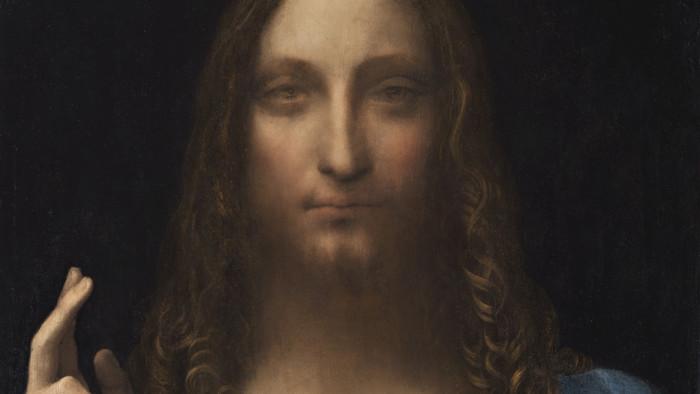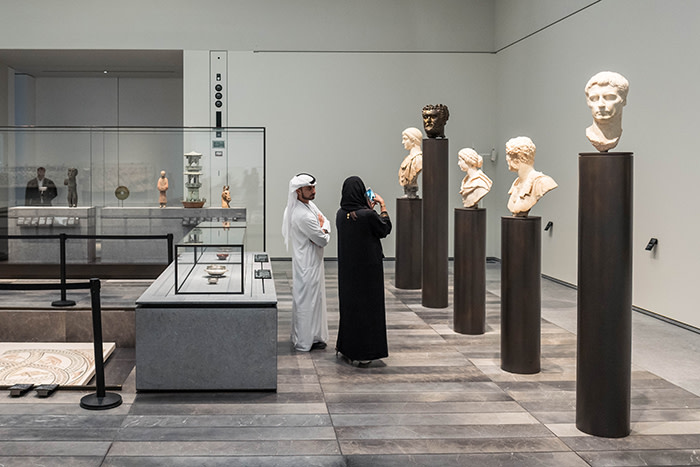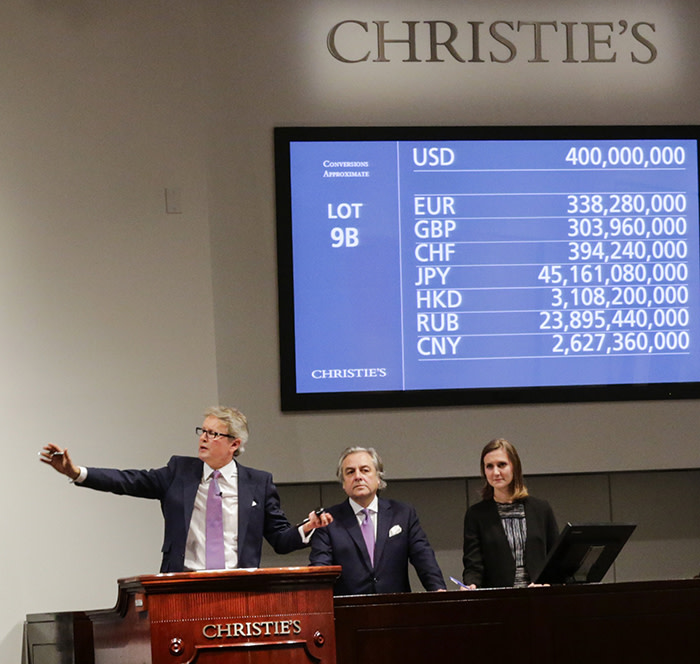$400m for a Leonardo da Vinci. Has the art world gone mad?
Simply sign up to the Life & Arts myFT Digest -- delivered directly to your inbox.

Never say never. It was beyond anyone’s wildest guess. On the evening of November 15 at Christie’s in New York, history was made when the hammer fell at $400,000,000. Or, putting it another way, a price not far off $1m per square inch, for Leonardo da Vinci’s “Salvator Mundi”.
Had the art market gone completely insane? Lost all connection with reason, with reality? On the Artnet website Tim Schneider likened it to “taking your dog out for its regular morning walk only for it to be snatched off the street by a pterodactyl”.
The freakish sale of the Leonardo work — or, according to the detractors, the remains of a historic picture very partially by Leonardo and very largely by the hand of skilled restorers — caused not only incredulity and amazement but also a sort of stunned revulsion. This, some people felt, was just too mad. It was perhaps the first inkling that a market that is undeniably exciting and exhilarating might be on the edge of becoming seriously troubling.
After a somewhat depressed year in 2016, when the auction houses saw their totals fall against previous seasons, 2017 has been a smash. Records have been broken, and a number of apparently irrational hammer falls saw dizzying prices for Jean-Michel Basquiat and others. In the coveted postwar and contemporary categories, prices in the high tens of millions have become a sort of new normal.
So how can this happen? Where on Earth does this money come from?
Georgina Adam, an art market expert and FT commentator, puts it quite simply. “Very rich people, these days, have an absolutely astonishing amount of available money,” she says. In other words, in the post-crash era of easy money, the billionaire class has not only grown but in many cases also expanded its disposable income. In her new book, Dark Side of the Boom: The Excesses of the Art Market in the 21st Century, a gallerist she interviews does the maths. If a couple has a net worth of $10bn, his example runs, they might well decide to put 10 per cent of that into trophy art for the walls of their many houses: $1bn of art. That billion will buy a great deal: in this context, $40m for a Picasso doesn’t seem so much.
And with blue-chip art, of course, there is always the lure of possible profits in the future, which is not the case with private jets or yachts or other depreciating purchases of the super-wealthy.
This sort of surreal arithmetic only has any meaning, of course, to less than 0.1 per cent of the 1 per cent, but it is still enough to drive this market to previously unimaginable extremes.

Yet even these calculations were defied by the Leonardo sale. When a social media post on Wednesday conveyed the news that the “Salvator Mundi” was going on show at the Louvre Abu Dhabi, it was swiftly followed by a real surprise: the buyer was a little-known Saudi prince, Bader bin Abdullah bin Mohammed bin Farhan al-Saud. It later emerged that he had been acting as a proxy for Crown Prince Mohammed bin Salman. Yet it was something of an anticlimax. That astronomical price just doesn’t seem so extraordinary any more — with a bottomless well of petrodollars, what’s the odd half-billion here or there? More intriguing, perhaps, is the identity of the underbidder, who — though noticeably slower — followed the leaps in bidding, until the final slam dunk bid of $30m. The best guess would be Qatar, which is itself opening a competing gleaming new Jean Nouvel-designed national museum next year, and is also in the middle of a spat with Saudi Arabia and United Arab Emirates.
It had to be a trophy buy: it was impossible to see how it could have been bought for purposes of investment. At that price level, the costs of buying and selling are enormous — for the Leonardo, fees alone exceeded $50m — and even for exceptional works the market is volatile. The seller of the Leonardo, Russian billionaire Dmitry Rybolovlev, may have scored a jackpot with that sale, but other blue-chip works he has sold recently have netted him punishing losses.
Art as investment is a relatively new phenomenon. Until the rapid price inflations of the 21st century, the potential for gain was too limited and too long-term. There are many experts in the field who still consider art to be a terrible investment — too illiquid, far too uncertain and burdened with heavy costs — but the dazzling rows of zeros, combined with an almost total lack of regulation, not only lure unwary investors but also provide a happy hunting ground for skilled manipulators of what Noah Horowitz, author of Art of the Deal: Contemporary Art in a Global Financial Market, describes as “a unique economy”.
As Adam points out, it’s not in fact a single market, but a range of markets loosely connected by the odd and awkward fact they all deal in unique cultural objects. The headline-grabbing sector, the locus of today’s gold rush, is fine art of the postwar and contemporary eras, and then only the very tip of a steep pyramid. The large middle ground doesn’t make the news. But throughout the sector there is no transparency, almost no regulation and a culture of almost obsessional secrecy. We don’t usually know the names of either buyer or seller in auction transactions, and in private sales not even the price — or indeed whether a sale has taken place at all. There is no register of transactions, or of ownership of works. The term “insider trading” does not apply — in fact you could say that all art trading depends on insider knowledge of some sort.
It’s a situation wide open to abuse, and the art business has its murky side. The principle of anonymity itself is a shock to many outsiders. As Sharon Cohen Levin, former chief of the asset forfeiture unit of the US attorney’s office in Manhattan, was quoted in the New York Times, “You can have a transaction where the seller is listed as ‘private collection’ and the buyer is listed as ‘private collection’. In any other business, no one would be able to get away with this.”
Another surprise is the system of guarantees for auction lots, whereby a third-party guarantees a price at auction (so the work is effectively pre-sold, keeping the seller risk-free) in exchange for a slice of the upside if the work should sell for more. Effectively a sophisticated form of gambling, it is perfectly legal, but nonetheless blamed by some experts for forcing up prices.
And there is nothing to stop the guarantor (who is anonymous, yet has had access to the reserve price of the work, which is also usually secret) joining the upward bidding herself. If the $100m guarantor of the Leonardo was also the successful bidder, she would have scored a big payback on the eventual price.
Art-world customs like this go beyond smoke and mirrors, pretty much into the realm of financial witchcraft. They certainly have nothing to do with art.
Or with artists, who often get brutally commodified by the market. The immense prices in postwar and contemporary work are achieved by only a very few, who have become transformed into brand names: Artnet reported that just 25 named artists were responsible for 44.6 per cent of auction totals in the sector in the first half of 2017. Olav Velthuis, professor at the University of Amsterdam, describes this as a “winner-takes-all” market also typical of actors, musicians and athletes.
So it’s hardly surprising to find questionable price manipulation of some of the star names. If, for instance, a dealer or collector owns a number of works by artist X, it’s essential that artist’s auction prices are never seen to flag: the collector might therefore dispatch agents to every auction in which X’s work comes up, to push up the bidding — and ensure the value of his existing holdings.
With dead artists, this seems cynical, sad even, but perhaps not tragic. Where such things can really matter is when it comes to the living, especially young or emerging talents who find themselves victims of this profit-mill. Adam gives a word-of-mouth example, which works as follows . . .
You buy 10 works by a young artist for, say, $10,000. After a year or so of planting bits of hype here and there, you place one work in an auction. You and a co-conspirator then bid the work up and up, say to $100,000. Once the hammer has fallen at that level — because the chief way of determining prices in art is simply by previous achieved prices — you can (slowly, no rushing) sell off the other nine works at similarly inflated rates. At an enormous profit.

Again, not actually illegal. And as this sort of thing depends so heavily on the cynicism and gullibility of buyers — who think they’ve got in early on the next great name — it’s hard to feel much sympathy for anyone in this sorry scenario. Like many art-market wrangles, no one really cares that much because it’s just seen as the rich playing games with each other, because they can. All except for the artist, whose career is unlikely to survive this sort of shenanigan.
Even those who seem to have successfully bucked the auction-house rules have sometimes come a cropper. The famous sale by Damien Hirst of his own new work at Sotheby’s, on the very day in 2008 that Lehman Brothers collapsed, made the artist a triumphant £111m — but the inflated prices torpedoed his own market. As critic Will Harrison says: “By 2009 . . . Hirst’s annual auction sales had shrunk by 93 per cent; since then, about a third of his works have failed to sell.” This time, it was collectors and investors who got bitten; Hirst’s battered reputation has been — for some — only restored by his mega-show in Venice this year.
Many art-world professionals are reluctant to be quoted about the reverses and failures of the auction market: relentlessly good news is de rigueur in a world where opinion and reputation are paramount. But auctions are not the only game in town: at Art Basel Miami Beach this week, its global director, Marc Spiegler, pointed out that art fairs (ie, the galleries that take part in them) now have 41 per cent of postwar and contemporary sales. Although he admits that the galleries’ business model is beleaguered, Spiegler claims the high ground for them in their care for art and artists: “I believe in galleries, I believe in the role that galleries play for artists — they are the ones that take the first huge risk, before the museum shows and biennials, and by taking that risk they make things possible for artists,” he says.
In the gallery system as well as in the auction houses, however, non-art-world commentators suggest darker crimes on art’s shadier side. Thomas Christ, a board member of the Basel Institute on Governance, a not-for-profit that pits itself against financial corruption, has described the art market as “an ideal playing ground for money-laundering” on the part of “smugglers, drug traffickers, arms dealers and the like”. While other sectors are increasingly squeezed by regulation, art assets are portable, hard to trace, and have internationally recognised value. Ideal indeed.
Adam points again to the famous opacity of transactions in this market. “Money laundering is very hard to prove, and rarely comes to public notice — that’s why everyone quotes the same five or six cases.” Yet art-world lore has plenty of instances of — for instance — using art as collateral for loans of “clean” money, or for currency transactions, or various forms of tax avoidance.
These are just a few of the many ways in which the market treats art merely as a tradeable commodity. Artists’ brand names trigger the price-points: beyond that, there often seems to be no aesthetic consideration at all.
Perhaps the saddest manifestation of this is in the trend for storage. With rising prices, and increasing internationalism, the seemingly dull issue of art storage has become very significant. It’s generally believed that as much as 80 per cent of the world’s art is in storage: a statistic that would surely make any artist, and any real art-lover, shudder. Works are now regularly bought and sold without even emerging from their well-guarded racks: “freeports” established in Switzerland and elsewhere not only offer specialist long-term care of works but also tax havens, and lavish facilities for viewing and trading works on-site, unobserved. The majority of transactions carried out in the freeports are no doubt legal, but the potential for illicit dealing is obvious.
Beyond any question of the law, however, or even of morality, the idea of these facilities — luxurious high-security prisons penning up millions of dollars’ worth of superb works of art, punished for being too expensive — is horrifying. It is surely a crazy consequence of crazy market forces — that works whose whole and only purpose is to be seen and appreciated are locked away. Something has gone seriously wrong with a society in which the value of art has become merely monetary.
Jan Dalley is the FT’s arts editor
The ‘Salvator Mundi’ story
The last da Vinci! This is how auction house Christie’s shouted up its biggest trophy sale — of “Salvator Mundi”, the only painting by Leonardo da Vinci still in private hands.
The painting, which belonged to Russian oligarch Dmitry Rybolovlev, was sent on a world tour before the sale, gathering admiring crowds. The auction house threw its weight into an unprecedented publicity campaign, with a video of Caravaggio-like portraits by star photographer Nadav Kander.
When the moment came, it smashed all expectations — and all records. The bidding jumped in huge leaps up to an astonishing $400m. The final, winning bid was an increment of $30m — take that!
For many years, the “last” Leonardo was actually the “lost” Leonardo. Commissioned in about 1500 by a French king, it probably came into the English royal collection when Henrietta Maria of France married Charles I in 1625. He, of course, lost his head, not to mention his art collection, but luckily Henrietta Maria had had an engraved copy made, by Wenceslaus Hollar, who wrote on it “Leonardus da Vinci pinxit” (Leonardo da Vinci painted this). That is how scholars knew it existed and knew what it looked like. Because it got lost. It changed hands then disappeared for a couple of centuries — only to re-emerge in mangled form, damaged, badly mended and crudely overpainted. In 1958 it was sold in London for £45, attributed to Beltraffio, a pupil of Leonardo’s, and was taken to America.
In 2005, it was bought by a consortium who funded a lengthy restoration. Sold to Swiss freeport entrepreneur Yves Bouvier for a reported $80m, he sold it on to Rybolovlev for $127m — whereupon Leonardo’s saviour got embroiled in a vicious lawsuit between the two men.
Rybolovlev’s triumphant sale, to the Saudi Prince Bader, made the billionaire even richer. But . . . the sheer amount of damage and restoration have led many people to question whether scholars are right to claim the picture as “by” Leonardo at all. A respected American scholar, David Nolta, has said he thinks it is “still a wreck” and will only speak of Leonardo’s “involvement with” the “Salvator Mundi”. Michael Daley, director of Artwatch UK, comments that the frame at least might be authentic.
A previous version of this article incorrectly identified Michael Daley as the author of the Grumpy Art Historian blog. Michael Daley is the director of Artwatch UK; Michael Savage is the Grumpy Art Historian.
Follow @FTLifeArts on Twitter to find out about our latest stories first. Subscribe to FT Life on YouTube for the latest FT Weekend videos
Comments